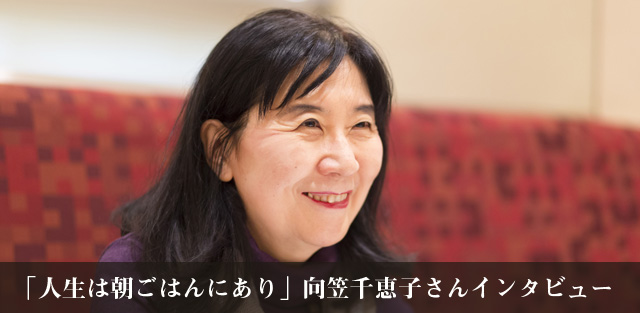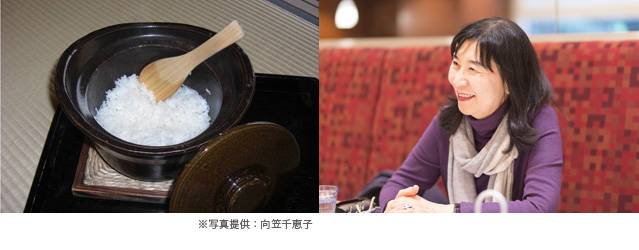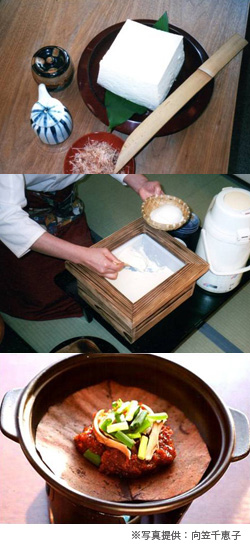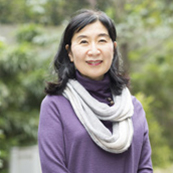#post_titleDiscover the Benefits of Breakfast in Japan
Mar 13,2014
#post_titleDiscover the Benefits of Breakfast in Japan
Mar 13,2014

“Breakfast is life”: An interview with Mukasa Chieko
Mukasa-san is a food specialist. But rather than a food producer, she’s a professional in conveying tastiness to consumers.
She’s particularly well-versed in asagohan, or Japanese breakfast, and has been pursuing the delights of the first meal of the day from a time when there was little talk about breakfast and extravagant dinners drew all the attention. Published in 1993, Nihon no asagohan (Breakfast in Japan) (Shinchosha Publishing Co, Ltd.), is the culmination of the early part of her career. From milk tofu at a dairy farming family in Hokkaido to a longevity-promoting meal in Okinawa, Mukasa has traversed Japan from north to south, sampling breakfast in every corner along the way. The resulting tome is a study of the modern Japanese dining table.
Let’s hear what Mukasa-san, who has paid close attention to breakfast in Japan for close to 30 years, has to say about the pleasures of the meal.
“You could say that compared to lunch and dinner, breakfast is the most individual of meals. After reporting on this individual act, I wanted to review my own diet. From my work, I knew that many people who value breakfast have brighter countenances, and more positive outlooks on life. They are delightful. Out of interest, did you eat breakfast this morning?”
Yes, I had a coffee and a veggie sandwich at a fast-food eatery.
I knew in advance that Mukasa-san asks everyone she crosses paths with about their breakfast, so I’d gone out of my way to ensure I’d had a balanced breakfast “including veggies” before our interview. Whew, glad that was sorted.
“Until 20 or 30 years ago, there were no real breakfast options in Tokyo except the coffee shop “morning set” of a thick slice of toast, coffee, boiled egg and maybe a tiny salad. These days, of course, there are any number of places to have breakfast if you so desire. Things have come a long way. Regardless, I don’t think the number of people who skip breakfast has changed all that much. Having worked until late, they are barely awake when they head back to the office and their morning energy comes from what is left of their dinner the night before. They only just get going in the afternoon, after their lunch. And so it goes day after day. Those who have to work from the morning have a good breakfast. Fishermen, farm people and others who move their bodies on the job, and even the hard-working types with jobs at companies, they all value their breakfast.”

So, the go-getters have breakfast. Ouch.
“The funny thing is, on special occasions, people don’t forget to have breakfast. Or instance, the Shinkansen super express train in the morning is filled with the smells of boxed meals. It’s delightful. When you think about it, a business trip is like riding into the enemy’s camp, right? It’s the same at cafeterias in departure areas of airports: they’re filled with people waiting for their flight. Whether you’re traveling for business or pleasure, this is one time you make sure to have a good breakfast, right?”
Now that she mentions it, I think she’s spot on. All of us secretly know we can’t concentrate on work or fun when we’re hungry, Perhaps the Japan’s GDP would go up if ate breakfast.

Photo credit: Mukasa Chieko
So what is an easy, nutritiously-sound breakfast. Mukasa-san recommends steamed rice topped with a raw egg.
“Eggs are a super capsule chock full of the nutrients needed to sustain the life of a chick. There’s fat, calcium, iron and a range of vitamins. At breakfast, we need a source of quick stamina (starch), a source of long-lasting stamina (fat) and a source of motivation (protein). Just topping steamed rice with a raw egg gives you a great breakfast that covers all three bases.”
And you can top the egg with a little soy sauce, some dried young sardines, or the delicious liquor from a tsukudani dish boiled in soy sauce.
“There are very few dishes that are as cheap and easy. You can heat frozen rice up in the microwave, but steaming rice in an earthenware pot is easy, too, so I’d love you to try it. You can successfully steam just one rice cup full, or even half. The earthenware pot in the photo is from a breakfast I had at an inn called Beniya Mukayu in Yamashiro Onsen (Ishikawa Prefecture). Washing an earthenware pot is easy, and once you get the hang of it, you can also make just the right amount of crispy of rice at the bottom of the pot. I’ve used and loved mine for a long time. You can make delicious rice in the 10 to 15 minutes it takes to slice some tsukemono pickled vegetables and make miso soup.”
Raw-egg-topped steamed rice + pickles + miso soup. It seems like a dream menu for one who eats out all the time, but it doesn’t seem like it would be that hard to realize.

Photo credit: Mukasa Chieko

Photo credit: Mukasa Chieko

Having explored breakfast in every nook and cranny of Japan, Mukasa-san admits that breakfast at Sakamoto in Noto (Ishikawa Prefecture) is best.
“It’s a tiny inn managed by a mother and son. At dawn, before it gets light, the preparation of home-made tofu begins with the mother grinding soaked soybeans with a mortar and pestle. The son rides a bicycle to pick up fresh-laid eggs from the poultry farm, just-picked vegetables from the morning market, and fish caught by fishermen and salted and dried overnight. They prepare the local produce thus gathered with great care. I know the Japanese word gochiso (“a feast”) literally means ‘make preparations at a gallop,’ but seeing it unfold before your eyes makes you appreciate the feast even more. The mother’s subtle timing when grilling the dried fish at the sunken hearth is sublime! I’m yet to encounter a breakfast that exceeds the one at Sakamoto.”
Mukasa-san says she’s noticed something while roaming the country eating deeply local breakfasts. And it has to do with her roots.
“When eating the local food in the prefectures that make up the Hokuriku area of Japan, the flavors were strangely nostalgic. I and both my parents may have been born in Tokyo, but our heritage traces back to Fukui. It finally made sense to me that my origins were there. I imagine many born in Tokyo say that they do not have a “home town,” but if they travel, I’m sure each one of them will experience something similar.”

Photo credit: Mukasa Chieko
Regardless of how developed distribution networks have become these days, there are many things that you cannot savor unless you actually visit the place. Mukasa-san is not looking for once-in-a-lifetime encounters, but once-in-a-lifetime meals.
“Take tofu, for instance. You extract soy milk from soybeans grown in the area and add nigari (bittern) to set it. The shimadofu at Hirayama Ryokan inn (Nagasaki Prefecture), the home-made tofu at Oyado Suehiro inn at Yunokawa Onsen (Iwate Prefecture)… For some reason, I’m drawn to tofu, but you can only eat freshly made tofu in situ. If you go to a coastal town, you’ll come across local fish only consumed in that area, and as the Japanese word temaemiso (literally “our miso,” meaning “self-flattery”) suggests, each region has its own miso and soy sauce flavor and uses. Another I remember fondly is hoba miso, where miso is broiled on a dried magnolia leaf (at Seseragi, Gifu Prefecture).”
These true regional foods can also be savored outside of luxury hotels and inns. Mukasa-san recommends green tourism accommodation. If you stay at a guest house on a farm, it won’t cost much, and the chances of being served more strongly local food are high.
“The ingredients served at breakfast will, nine times out of ten, be staple foods of the locals, and there is a story to each and every one. Then there are the miso, soy sauce and dashi stock that bring out the best of these ingredients. I came to know the richness of Japan, as well as myself, through breakfast.”
And your everyday dining table is waiting for you when you get home from your travels.
“When we’re first back home, we get excited to eat our usual full breakfast, but there will be something that takes our attention, or we are super busy, and somehow we end up skipping breakfast. That’s the reality of it, I suppose. But I’d like you to eat something, even if just a bite. It could even be some tofu or natto you bought the day before. It doesn’t need to be a perfect breakfast like you get at an inn. But if you just eat something, you’ll turn on a switch that will give you the motivation to make something of your day.”
So, what will you be having for breakfast tomorrow?”

Food journalist, food culture researcher, essayist
Food journalist, food culture researcher, essayist
Mukasa was born in Nihonbashi, Tokyo. She visits Japan’s culinary frontlines to talk to dedicated producers and, viewing each place she visits from folk custom, historical and other facets, discusses the food we eat today. After serving as a member of the Ministry Agriculture, Forestry and Fisheries’ committee to select 100 traditional dishes of agricultural and fishing villages , she served as president of the Ministry’s Eating Amenity Contest jury, specialist jury member for Honbano Honmono , and President of the Kyodo Ryori School . She is an avid participant in conversations around agriculture and eating and producers and consumers, as well as the slow food movement.
Mukasa appears on NHK’s Radio Shinyabin. She has authored numerous books. Her Shoku no gaito o yuku (12 Roads and Stories of the Foods) (Heibonsha Shinsho) won Best Culinary Travel Guide at the Gourmand World Cookbook Awards.